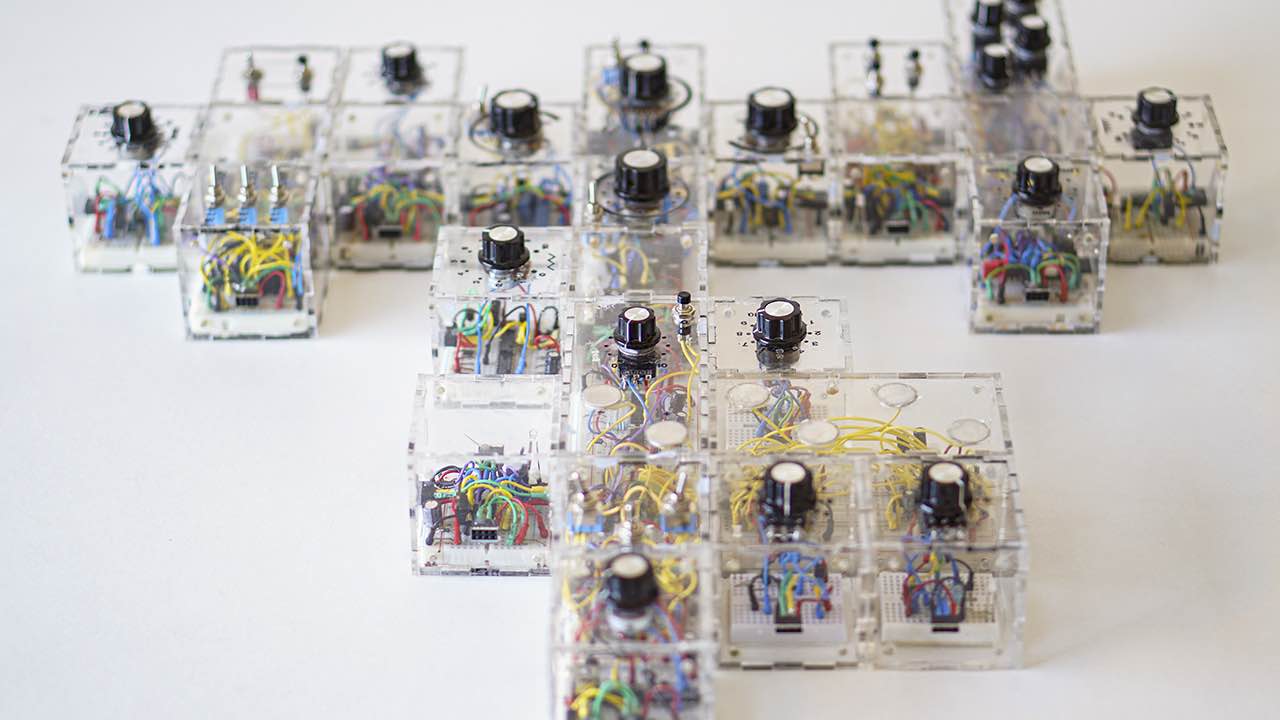The Hypercubes
"The Hypercubes" conform a new electronic musical instrument integrated by see-through cubes with electronic components inside, allowing you to work with electronic music in a much more physical way. By connecting the modules together you can generate, modify and control pure electronic sounds without the need to use computers. Connect as many cubes as you need according to the complexity of the sound that you want to create, or vary the way they are placed to alter the resulting circuit. The perfect music for a robot funeral!
 "The Hypercubes" (2014) is an analog modular system in which instead of patching cables you use the physical modules snapped together to route the signal in and out of each cube, thus creating sounds. It's a tool to work with electronic music in a physical way, since each one of the modules is a different tangible object. It's also self-sufficient regarding the sound material it uses: electricity goes in and sound goes out. No MIDI, samples nor arduino. The connections between each cube are pure electronic signals transferring through pins, with magnets to hold them together. As in any electronic (or acoustic) instrument, the sonic possibilities are divided in generators, modifiers and controllers. Each one of these groups include several different cubes.
"The Hypercubes" (2014) is an analog modular system in which instead of patching cables you use the physical modules snapped together to route the signal in and out of each cube, thus creating sounds. It's a tool to work with electronic music in a physical way, since each one of the modules is a different tangible object. It's also self-sufficient regarding the sound material it uses: electricity goes in and sound goes out. No MIDI, samples nor arduino. The connections between each cube are pure electronic signals transferring through pins, with magnets to hold them together. As in any electronic (or acoustic) instrument, the sonic possibilities are divided in generators, modifiers and controllers. Each one of these groups include several different cubes.Generators: simple wave oscillators (Sin, Sq, Tri and Saw) + White/Pink noise sources
Modifiers: Filters, distortion, EQ, Delay...
Controllers: Envelopes, Arpeggiator, Sequencer, Pan controller...
You can add more and more cubes depending on the complexity of the sound you want to (re)create, moreover, due to the special inner circuits configuration, mostly all cubes can be connected in more that one spot in the final circuit, so you can relocate them in a variety of ways.
Each cube can be controlled with knobs, switches, buttons or touch plates located in the top. Some have just one parameter to modify (as in a Saw generator, the frequency) but others much more (as in a filter, the Q, resonance, bandwidth...). For the sequencer or arpeggiator circuits, each one of the steps (which are independent cubes) can be attached or detached for the notes to be on/off, adjusting the frequency with each respective knob.
The circuits are breadboarded for the player to change every other component on the fly as his sound needs, so being able to "edit" the circuits as much as he wants.
Mateo Mena
: Electronic luthier

Hi! My name is Mateo Mena and I make:
🌳⚡️Artisanal electronic instruments
📼 Animated videos
🤘🏻 A/V Shows
👨🏻🏫 Workshops
As a passionate person since my childhood in electricity and sound, I have been investigating for the last decade in ways and materials to create new electronic instruments.
After graduating with a degree in Electronic Engineering and Musical Composition, I continued my academic training studying artisanal construction of musical instruments and goldsmithing, in an attempt to reduce my working materials to those sustainable ones such as wood, metals or glass.
I've presented to the Maker Music Festival two of my designs, the "Hypercubes" and the "Serinette". I think this will be a really good opportunity to contact with other inventors and makers around the world, and make interesting connections! Feel free to check my other works too and, if you feel like to, drop me a line through my IG account www.instagram.com/_mateomena/
See you!
🌳⚡️Artisanal electronic instruments
📼 Animated videos
🤘🏻 A/V Shows
👨🏻🏫 Workshops
As a passionate person since my childhood in electricity and sound, I have been investigating for the last decade in ways and materials to create new electronic instruments.
After graduating with a degree in Electronic Engineering and Musical Composition, I continued my academic training studying artisanal construction of musical instruments and goldsmithing, in an attempt to reduce my working materials to those sustainable ones such as wood, metals or glass.
I've presented to the Maker Music Festival two of my designs, the "Hypercubes" and the "Serinette". I think this will be a really good opportunity to contact with other inventors and makers around the world, and make interesting connections! Feel free to check my other works too and, if you feel like to, drop me a line through my IG account www.instagram.com/_mateomena/
See you!
Connect with Mateo Mena
How I can help you:
I provide workshops of electronic instrument making around Europe when I'm on tour (oh, those good pre pandemic years...) But hey! I hope to resume touring this summer, so if you have any interesting proposals for shows or workshops just drop me a line!
I provide workshops of electronic instrument making around Europe when I'm on tour (oh, those good pre pandemic years...) But hey! I hope to resume touring this summer, so if you have any interesting proposals for shows or workshops just drop me a line!
How you can help me:
Send money $$$
Send money $$$